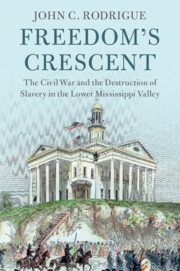Book contents
- Freedom’s Crescent
- Cambridge Studies on the American South
- Freedom’s Crescent
- Copyright page
- Dedication
- Epigraph
- Contents
- Figures
- Acknowledgments
- Abbreviations
- Additional material
- Introduction
- Prologue Life – and Labor – on the Mississippi
- Part I From War for Union to Military Emancipation, 1860–1862
- 1 “An Independent Power”
- 2 Of Stampedes and Free Papers
- 3 “Broken Eggs Cannot Be Mended”
- 4 “The Unsatisfactory Prospect Before Them”
- Part II From Military Emancipation to State Abolition, 1863
- Part III Abolition: State and Federal, 1864
- Part IV The Destruction of Slavery, 1865
- Epilogue Memphis and New Orleans: May 1–3 and July 30, 1866
- Bibliography
- Index
1 - “An Independent Power”
from Part I - From War for Union to Military Emancipation, 1860–1862
Published online by Cambridge University Press: 19 January 2023
- Freedom’s Crescent
- Cambridge Studies on the American South
- Freedom’s Crescent
- Copyright page
- Dedication
- Epigraph
- Contents
- Figures
- Acknowledgments
- Abbreviations
- Additional material
- Introduction
- Prologue Life – and Labor – on the Mississippi
- Part I From War for Union to Military Emancipation, 1860–1862
- 1 “An Independent Power”
- 2 Of Stampedes and Free Papers
- 3 “Broken Eggs Cannot Be Mended”
- 4 “The Unsatisfactory Prospect Before Them”
- Part II From Military Emancipation to State Abolition, 1863
- Part III Abolition: State and Federal, 1864
- Part IV The Destruction of Slavery, 1865
- Epilogue Memphis and New Orleans: May 1–3 and July 30, 1866
- Bibliography
- Index
Summary
The secession crisis of 1860-61 in the lower Mississippi valley represents the crisis in the South as a whole. Secession is more contentious, and southern Unionism more prevalent, in Arkansas and Tennessee than in Louisiana and Mississippi. Support for secession initially corresponds to areas of plantation agriculture and large slaveholdings, but the Confederacy receives overwhelming white support after secession. Events outside the region shape the Union’s initial approach to the rebellion and to the problem of fugitive slaves, though the region also experiences internal disruptions in mobilizing for war. The lower Mississippi valley initially experiences little direct effect from the war, but control of the Mississippi River soon becomes central to Union strategy. By early 1862, preparations were underway for Federal incursions into the region. Although the issue of slavery becomes unavoidable, notions of “Reconstruction” remain limited, and few Northerners envision a reunion predicated on the abolition of slavery.
- Type
- Chapter
- Information
- Freedom's CrescentThe Civil War and the Destruction of Slavery in the Lower Mississippi Valley, pp. 43 - 64Publisher: Cambridge University PressPrint publication year: 2023



